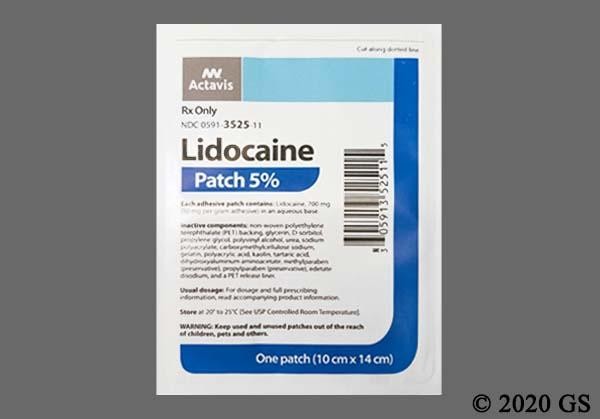
Contents
- 1 lidocaine transdermal
lidocaine transdermal
Lidocaine transdermal is a local anesthetic applied as skin patches to relieve postherpetic neuralgia (PHN), nerve pain that can linger after an attack of shingles. Lidocaine transdermal used for postherpetic neuralgia is a prescription medication, but some formulations of lidocaine transdermal patches are also available over-the-counter, for temporary relief from minor pain in patients 12 years of age or older.
Lidocaine transdermal relieves pain by blocking the nerve ends from sending pain signals to the brain. The medication in the lidocaine transdermal patch is absorbed by the skin continuously over a few hours until the patch is removed. Lidocaine absorbed by the skin is sufficient to produce local pain relief, but is not strong enough to numb the region.
Warnings
- Do not use lidocaine transdermal in patients with known hypersensitivity to amide type of local anesthetics, or to any of the components in lidocaine patch
- Patients with severe liver disease are at greater risk for increased blood concentration of lidocaine patch because the drug is metabolized by the liver; use with caution
- Patients allergic to para-aminobenzoic acid (PABA) derivatives such as procaine, tetracaine, benzocaine have not shown cross-sensitivity to lidocaine; however, the potential exists; use with caution
- If used along with other local anesthetic agents, the total amount of drug absorbed from all formulations must be considered
What are the side effects of lidocaine transdermal?
Common side effects of lidocaine transdermal include:
- Application site reactions that may include:
- Blisters (vesicles)
- Bruising
- Irritation or burning sensation
- Itching (pruritus)
- Depigmentation
- Discoloration
- Dermatitis
- Redness (erythema)
- Peeling skin (exfoliation)
- Swelling (edema)
- Bumps in the skin (papules)
- Abnormal sensation
- Weakness (asthenia)
- Tremor
- Confusion
- Drowsiness (somnolence)
- Disorientation
- Nervousness
- Lightheadedness
- Dizziness
- Headache
- Heightened skin sensitivity (hyperesthesia)
- Reduced skin sensitivity (hypoesthesia)
- Abnormal skin sensation (paresthesia)
- Exacerbated pain
- Metallic taste
- Taste alteration
- Nausea
- Vomiting
- Flushing
- Visual disturbances such as blurred vision
- Ringing in the ears (tinnitus)
- Eye irritation
- Allergic and anaphylaxis-like reactions including:
- Swelling in the tissue under the skin or mucous membranes (angioedema)
- Bronchospasm
- Dermatitis
- Shortness of breath (dyspnea)
- Spasm of the voice box (laryngospasm)
- Hives (urticaria)
- Itching (pruritus)
- Shock
This is not a complete list of all side effects or adverse reactions that may occur from the use of this drug. Call your doctor for medical advice about serious side effects or adverse reactions. You may also report side effects or health problems to the FDA at 1-800-FDA-1088.
QUESTION
What are the dosages of lidocaine transdermal?
Transdermal Patch
- 5%; 700mg/patch (Lidoderm; Rx)
- 1.8%; 36mg/patch (ZTlido; Rx)
- 4% (Lidocare Patch; OTC)
Postherpetic neuralgia pain
- Lidoderm 5% or ZTlido 1.8%
- Lidoderm 5% transdermal patch: Apply to intact skin to cover the most painful area
- Apply up to 3 patches, only once for up to 12 hours within a 24-hour period
- Patches may be cut into smaller sizes with scissors prior to removal of the release liner
- Clothing may be worn over the area of application
- Smaller areas of treatment are recommended in a debilitated patient, or a patient with impaired elimination
Temporary pain relief
In adults and adolescents of age 12 years or more
- Lidocare 4% transdermal patch: Apply patch to affected area every 8-12 hours as needed
- May leave patch on skin for up to 8 hours, but no more than 12 hours
Dosing considerations
- One ZTlido (lidocaine topical system) 1.8% provides equivalent lidocaine exposure to one Lidoderm (lidocaine patch 5%)
- If used concomitantly with other products containing local anesthetic agents, the total amount of drug absorbed from all formulations must be considered
Overdose
- Overdose from absorption from skin patch is rare, however, it is possible.
- If there is a suspicion of overdose, blood concentration of lidocaine should be checked, and treated with supportive and symptomatic therapy.
What drugs interact with lidocaine transdermal?
Inform your doctor of all medications you are currently taking, who can advise you on any possible drug interactions. Never begin taking, suddenly discontinue, or change the dosage of any medication without your doctor’s recommendation.
There are no known interactions of lidocaine transdermal with other drugs. Use caution in concomitant use with:
- Class 1 antiarrhythmic drugs such as:
- tocainide
- mexiletine
The drug interactions listed above are not all of the possible interactions or adverse effects. For more information on drug interactions, visit the RxList Drug Interaction Checker.
It is important to always tell your doctor, pharmacist, or health care provider of all prescription and over-the-counter medications you use, as well as the dosage for each, and keep a list of the information. Check with your doctor or health care provider if you have any questions about the medication.
Pregnancy and breastfeeding
- Animal studies show no harm to the fetus from lidocaine transdermal, however, no controlled studies have been conducted in pregnant women; use only if clearly needed.
- Lidocaine transdermal is excreted in breast milk; use with caution in nursing mothers.
What else should I know about lidocaine transdermal?
- Apply on clean, dry, intact skin; applying on broken or inflamed skin can increase absorption and blood concentration of lidocaine.
- Keep out of reach of children and dispose of used patches carefully; used lidocaine patches contain a large amount of lidocaine.
- If irritation or a burning sensation occurs during application, remove the lidocaine patch and do not reapply until the irritation is gone.
- Protect lidocaine patch from direct heat such as heating pads and electric blankets; they can increase systemic absorption.
- Do not apply for longer duration, more often, or more patches than recommended; follow the doctor’s directions, or in the case of over-the-counter lidocaine patches, follow the package instructions exactly.
- Do not let lidocaine transdermal come into contact with your eyes; if it does, immediately wash the eye with water or saline and protect the eye until sensation returns.
By clicking Submit, I agree to the MedicineNet’s Terms & Conditions & Privacy Policy and understand that I may opt out of MedicineNet’s subscriptions at any time.
Summary
Lidocaine transdermal is a skin patch used to relieve postherpetic neuralgia (PHN), nerve pain after an attack of shingles. Common side effects include application site reactions. There are no known interactions with other drugs. Consult your doctor before using lidocaine transdermal if pregnant or breastfeeding.


